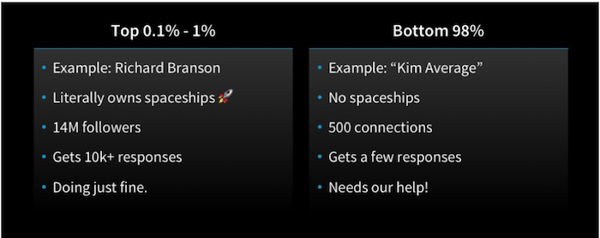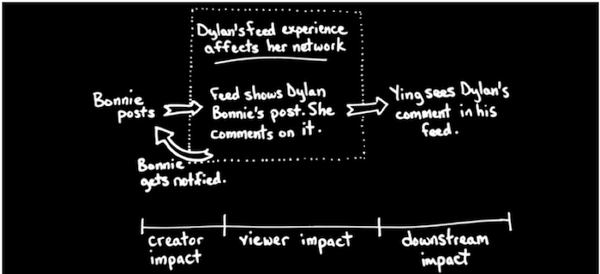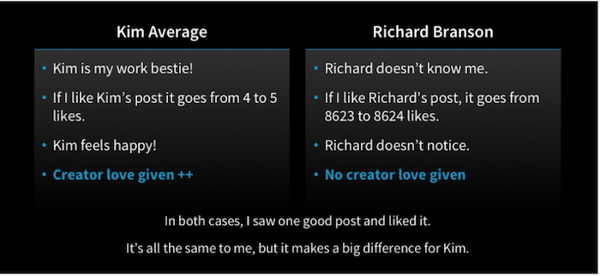LinkedIn announced today that it plans to overhaul its feed ranking system to help more creators get better engagement on the content they share.
The changes were spurred when the professional networking site discovered that the top 1% of content creators -- also known as "power users," or perhaps influencers -- were receiving the vast majority of engagement with their posts.
Meanwhile, the remaining 98%, the site says, was "receiving less [engagement] than ever."
Here's how that skew in engagement happened -- and how LinkedIn has changed its algorithm to address the problem.
Why LinkedIn Changed Its Feed Ranking Algorithm
Year over year, LinkedIn has experienced noticeable growth in overal engagement with posts appearing in its feed -- an average increase of over 50%, the company says.
Much of the time, that engagement results in a post going viral -- that is, LinkedIn members engage with certain posts to the point where the content earns "tens of millions" of likes, comments, and reshares.
On the surface, that seems like a positive development. But, LinkedIn says, there was a problem: The engagement was not evenly distributed, and the site was "in danger of creating an economy where all the gains in viral actions accrued to the top 1% power users."
Typically, the most popular posts on any social network tend to gain more visibility, which is what was happening to content shared by top influencers.
Emerging brands and content creators, meanwhile, were actually receiving less and less engagement on their posts.

Source: LinkedIn
Besides the obvious issue of this uneven distribution of causing the "richest" content creators on the site -- the influencers who already have a large following -- to become "richer," the lack of engagement with the remaining 98% of followers was actually discouraging them from posting again in the future.
That only exacerbated the virality gap, as less content-sharing altogether from the bottom 98% would lead to more eyes on posts from top influencers.
So, LinkedIn formulated a solution.
Why Linkedin's New Algorithm Could Be a Game-Changer for Marketers
The changes to LinkedIn's new ranking criteria is multi-fold.
Prior to this overhaul, the feed would prioritize posts according to how likely a given viewer was to engage with it -- to like, comment on, or reshare it. That model also took into account the given viewer's network, and how likely it was to respond to this content in kind.
What was missing was how likely the creator or poster of that content was to "appreciate" the engagement. To put that discrepancy into context, LinkedIn's Bonnie Barrilleaux and Dylan Wang -- who authored the company's announcement -- explain that for major influencers within "the top 1% of creators, one more like or comment from an unknown follower may not mean much."
For smaller or emerging content creators, however, these likes and comments go a long away. According to Barrilleaux and Wang's findings, creators who receive 10 or more likes on their content are 17% more likely to post again in the following week.
That's why the feed algorithm has been modified to include signals that indicate how much value the creator will place on viewer feedback received on a post.
"The effect is that we are redistributing a little bit of the attention in the system from the power users to the other creators, so that no one is left behind," write Barrilleaux and Wang. "This helps ensure that the 'small' creators who create high-quality posts can reach out to the community that cares about them."

Source: LinkedIn
Additionally, LinkedIn's algorithm changes appear to be moving in a similar direction as that of Facebook, when the social media giant overhauled its News Feed to prioritize content from family and friends over that from Pages.
We've already covered the three pillars that LinkedIn's new model takes into account when ranking creator content:
- How likely a viewer is to engage with a creator's post
- How much that viewer's network will want to see it
- How much the original creator will appreciate the first 10 likes of that post
But there could be a fourth, according to the figure below -- which is whether or not the content creator is within the viewer's network.

Source: LinkedIn
It's also possible that these moves from LinkedIn could serve as a subtle nod to the drop in Business Page engagement and reach experienced by brands on Facebook -- for some, a decline of 50%.
LinkedIn's algorithm change -- especially within the context of boosting engagement for smaller, emerging content creators -- does spark the question: Is this the company's way of giving smaller brands and figures a chance to shine on another network, where it may have lost reach on another one?
Perhaps. But more than that, says HubSpot CMO Kipp Bodnar, LinkedIn is also responding to a growing user demand for a relevant, personalized experience.
"LinkedIn's core job is to great a valuable experience for all users. Once a news feed becomes dominated by a small subset of users, then it starts to become less valuable to the broader community," Bodnar explains. "The company is trying to deliver more value through more personalization."
So, what kind of impact will this have on the bigger influencers -- the top 1% of content creators on LinkedIn?
According to Barrilleaux and Wang, it won't be much, pointing back to the overall growth in engagement received by all posts in LinkedIn's feed.
"Taking 8% of the likes away from the top 0.1% still leaves them better off than they were a year ago," they write. "These changes just help ensure that the rising tide is lifting all the boats in a fair and equitable fashion."
But should this trend continue, LinkedIn could move further in the direction of Facebook, and re-allocate a growing amount of post engagement from top creators to emerging ones.
"This might not be a huge impact on top creators today but I think that over time they will continue to push in this direction," says Bodnar. "The audience for posts from top creators could continue to decrease."
LinkedIn says it will continue to observe and optimize its algorithm as these changes take effect.
from Marketing https://blog.hubspot.com/marketing/new-linkedin-feed-algorithm
No comments:
Post a Comment